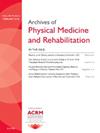Feasibility Randomized Controlled Trial of the Toolkit for Optimal Recovery After Concussion: A Live Video Program to Prevent Persistent Concussion Symptoms in Young Adults With Anxiety
IF 3.6
2区 医学
Q1 REHABILITATION
Archives of physical medicine and rehabilitation
Pub Date : 2025-04-01
DOI:10.1016/j.apmr.2024.10.011
引用次数: 0
Abstract
Objectives
To assess the feasibility of the Toolkit for Optimal Recovery after Concussion (TOR-C), the first mind-body program aiming to prevent persistent concussion symptoms among young adults with anxiety, and an active control (Health Enhancement after Concussion [HE-C]). We also tested preliminary improvements in outcome measures and putative mechanistic targets.
Design
Single-blind, 2-arm, randomized controlled trial (RCT).
Setting
Academic medical center in the US Northeast.
Participants
Fifty young adults (aged 18-35 years) with a recent concussion (3-10 weeks prior) and anxiety (≥5 on the Generalized Anxiety Disorder-7 [GAD-7] questionnaire).
Interventions
Both interventions consisted of four 45-minute 1:1 sessions with a clinician over Zoom. TOR-C (n=25) taught mind-body, cognitive-behavioral, and return-to-activity skills. HE-C (n=25) taught health education (eg, sleep, nutrition) without skills.
Main Outcome Measures
Primary: feasibility outcomes (eg, recruitment, credibility, expectancy, acceptability, safety, feasibility of assessments, fidelity, satisfaction, and TOR-C homework adherence) with a-priori-set benchmarks. Secondary: intervention outcomes were concussion symptoms (Post-Concussion Symptom Scale), physical function (World Health Organization Disability Assessment Scale), anxiety (GAD-7/anxiety subscale of the Hospital Anxiety and Depression Scale), depression (depression subscale of the Hospital Anxiety and Depression Scale) and pain (Numerical Rating Scale). TOR-C mechanistic targets were pain catastrophizing (Pain Catastrophizing Scale), mindfulness (Cognitive and Affective Mindfulness Scale-Revised), fear avoidance (Fear Avoidance Behavior after Traumatic Brain Injury), limiting behavior and all-or-nothing behavior (Behavioral Response to Illness Questionnaire).
Results
Both interventions met all feasibility benchmarks and were associated with significant improvements in outcomes (concussion symptoms, physical function, anxiety, depression, and pain; d=0.44-1.21) and TOR-C mechanistic targets (pain catastrophizing, mindfulness, fear-avoidance, and limiting behavior; Cohen's d=0.41-1.24). Improvements in all-or-nothing behavior were only significant in TOR-C (d=0.52). Improvements in all mechanistic targets except all-or-nothing behavior after TOR-C were significantly associated with improvements in at least one outcome.
Conclusions
Findings provide strong support for the feasibility of TOR-C and HE-C, and preliminary evidence for improvements in mechanistic targets and outcomes. Findings inform a future fully-powered RCT testing efficacy of TOR-C versus HE-C.
脑震荡后最佳恢复工具包的可行性随机对照试验:预防患有焦虑症的年轻成年人持续出现脑震荡症状的实时视频计划。
目的:评估脑震荡后最佳恢复工具包(TOR-C)的可行性:评估 "脑震荡后最佳恢复工具包"(TOR-C)和积极对照组(脑震荡后健康增强;HE-C)的可行性。"TOR-C "是首个旨在预防患有焦虑症的年轻成年人出现持续性脑震荡症状的身心项目。我们还测试了在结果测量和推测机制目标方面的初步改进:设计:单盲、双臂、随机对照试验:地点:美国东北部的学术医疗中心:50名近期有脑震荡(3-10周前)和焦虑(GAD7问卷≥5分)的年轻人(18-35岁):两种干预都包括四次 45 分钟的 1:1 课程,由一名临床医生通过 Zoom 进行指导。TOR-C(人数=25)教授身心、认知行为和恢复活动技能。HE-C(人数=25)教授健康教育(如睡眠、营养),不提供技能:主要结果:可行性结果(如招募、可信度、期望值、可接受性、安全性、评估的可行性、忠实性、满意度、TOR-C 家庭作业的坚持性)与事先设定的基准。次要:干预结果包括脑震荡症状(PCSS)、身体功能(WHODAS)、焦虑(GAD7/HAD-A)、抑郁(HADS-D)和疼痛(NRS)。TOR-C 机制目标是疼痛灾难化(PCS)、正念(CAMS-R)、恐惧回避(FAB-TBI)、限制行为和全有或全无行为(BRIQ):结果:两种干预措施均符合所有可行性基准,并显著改善了结果(脑震荡症状、身体功能、焦虑、抑郁和疼痛;d=0.44-1.21)和 TOR-C 机制目标(疼痛灾难化、正念、恐惧回避和限制行为;Cohen's d=0.41-1.24)。全有或全无行为的改善仅在 TOR-C 中具有显著性(d=0.52)。TOR-C治疗后,除全或无行为外,所有机理目标的改善都与至少一种结果的改善有显著关联:研究结果为 TOR-C 和 HE-C 的可行性提供了有力支持,也为机理目标和结果的改善提供了初步证据。研究结果为未来测试TOR-C与HE-C疗效的全效RCT提供了依据。
本文章由计算机程序翻译,如有差异,请以英文原文为准。
求助全文
约1分钟内获得全文
求助全文
来源期刊
CiteScore
6.20
自引率
4.70%
发文量
495
审稿时长
38 days
期刊介绍:
The Archives of Physical Medicine and Rehabilitation publishes original, peer-reviewed research and clinical reports on important trends and developments in physical medicine and rehabilitation and related fields. This international journal brings researchers and clinicians authoritative information on the therapeutic utilization of physical, behavioral and pharmaceutical agents in providing comprehensive care for individuals with chronic illness and disabilities.
Archives began publication in 1920, publishes monthly, and is the official journal of the American Congress of Rehabilitation Medicine. Its papers are cited more often than any other rehabilitation journal.

 求助内容:
求助内容: 应助结果提醒方式:
应助结果提醒方式:


